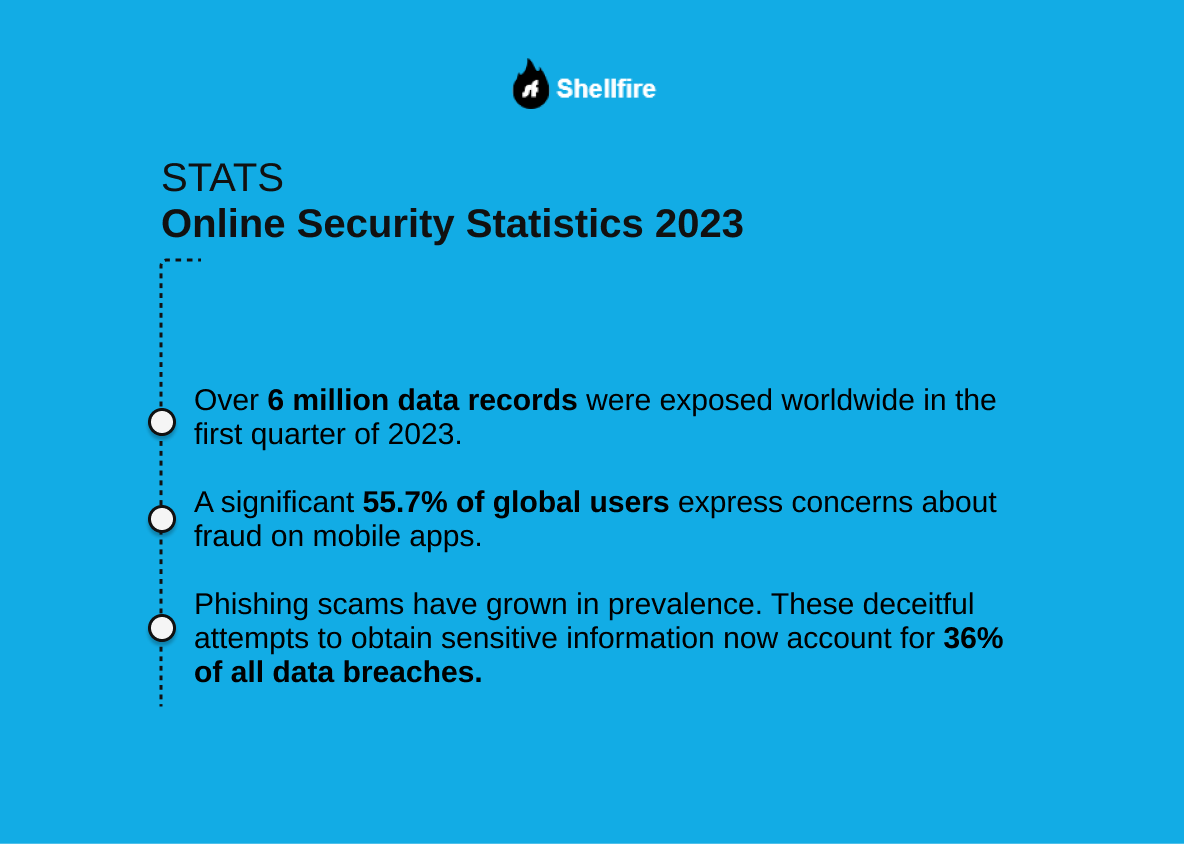Online Security Statistics 2023: The Current State of Digital Threats
In our increasingly digital era, online security has never been more critical. With the proliferation of digital transactions, communications, and data storage, the threats posed by cybercriminals have grown more sophisticated and frequent.
The importance of online security can’t be overstated, as it safeguards not just our personal information but also the very fabric of businesses and essential infrastructure. This article dives deep into the latest statistics on online security, offering a holistic view of the challenges we face and the imperative for robust security measures.
Table of Contents
Key Stats
- Phishing scams account for nearly 36% of all data breaches.
- 54% of ransomware infections are caused by phishing scams.
- Over 6 million data records were exposed worldwide in the first quarter of 2023.
- 55.7% of mobile app users worldwide are concerned about fraud.
Unraveling the Threat: Online Security Vulnerabilities and Concerns

Phishing Scams: A Persistent Menace – 36% of Data Breaches
Phishing scams have grown in prevalence. These deceitful attempts to obtain sensitive information now account for 36% of all data breaches.
Moreover, a staggering 83% of companies reported facing a phishing attack in 2021, emphasizing the ubiquity of this threat (1).
Ransomware: The Cost of Complacency – 54% Attributed to Phishing
Ransomware attacks are on the rise. In 2020, phishing scams were the cause behind 54% of ransomware infections.
Further data from 2022 shows that 37% of global organizations faced between four to six ransomware infections, with 6% enduring ten or more separate infections (2).
Data Breaches and The Exposed World – 6 Million Records in Q1 2023 Alone
Data breaches have had a substantial impact, with over 6 million records exposed worldwide in just Q1 2023. Among these breaches, the most substantial was the Cam4 incident in 2020, revealing over 10 billion records (4).
Such breaches have widespread implications, from immediate financial losses to enduring reputational damage.
The Data Avalanche and its Implications – 175 Zettabytes by 2025
With the accumulation of data in our digital age, projections estimate that by 2025, the world will be dealing with a massive 175 zettabytes of data, from personal to corporate records (6).
This vast trove of information presents tempting opportunities for cybercriminals.
A Growing Concern, Mobile App Threats: 55.7% Fear Fraud
With the proliferation of mobile devices, security concerns have shifted in part to mobile apps.
A significant 55.7% of global users express concerns about fraud on mobile apps, with over half apprehensive about the potential hacking of their apps (7).
The Password Paradox – 27% Fear Hacking of Software
Password managers, designed to enhance online security, are not universally embraced. A notable 27% of users resist adoption, primarily due to fears that their password management software might itself be hacked (8).
Social Media: The New Battlefield – 21% of Organizations Targeted
Social media, the cornerstone of modern communication, is not without its vulnerabilities. In 2021, a concerning 21% of organizations reported facing between one to ten cyberattacks originating from these platforms (10).
Conclusion
Online security, once a secondary concern, has now been thrust to the forefront in today’s interconnected world. From phishing scams to colossal data breaches, the threats are manifold and ever-evolving. However, the promise of VPNs for cybersecurity presents a beacon of hope. Virtual Private Networks (VPNs) like Shellfire VPN offer an added layer of security, making it challenging for cybercriminals to intercept data or track users’ activities.
By understanding these challenges and leveraging tools like VPNs, individuals and organizations can take proactive steps, ensuring they navigate the digital realm safely and confidently. If you’re looking for a reliable way to bolster your online security, consider.
Literature
- Techopedia. 50+ Phishing Statistics You Need to Know – Where, Who & What is Targeted. Available from: https://www.techopedia.com/phishing-statistics ↩
- Statista. Most common delivery methods and cybersecurity vulnerabilities causing ransomware infections according to MSPs worldwide as of 2020. Available from: https://www.statista.com/statistics/700965/leading-cause-of-ransomware-infection/ ↩
- Statista. Volume of ransomware infections in organizations worldwide in 2022. Available from: https://www.statista.com/statistics/1351338/global-volume-ransomware-organizations/ ↩
- Statista. Number of data records exposed worldwide from 1st quarter 2020 to 1st quarter 2023. Available from: https://www.statista.com/statistics/1307426/number-of-data-breaches-worldwide/ ↩
- TechTarget. 34 cybersecurity statistics to lose sleep over in 2023. Available from: https://www.techtarget.com/whatis/34-Cybersecurity-Statistics-to-Lose-Sleep-Over-in-2020 ↩
- Statista. Most concerning cyber security issues on mobile apps according to users worldwide in 2022. Available from: https://www.statista.com/statistics/1381432/mobile-app-usage-cyber-threats-consumers-worldwide/ ↩
- Statista. Most important reasons for not using a password manager worldwide in 2022. Available from: https://www.statista.com/statistics/1305962/reasons-not-to-use-a-password-manager-worldwide/ ↩
- Statista. Volume of social media attacks on organizations worldwide in 2021. Available from: https://www.statista.com/statistics/1149299/share-social-media-attacks-organizations-experienced/ ↩

